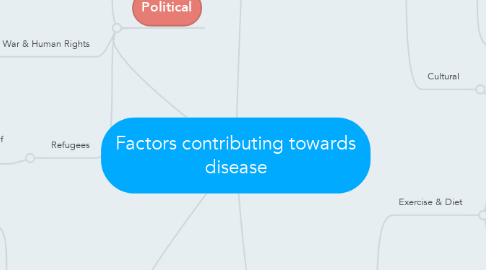
1. Physical
1.1. Water & Soil
1.1.1. Ltd access to safe & clean water
1.1.2. Leached soils due to either too much rainfall or dry windy conditions
1.1.3. Lack of fertile soils
1.1.3.1. Leached soils due to either too much rainfall or dry windy conditions Leached soils due to either too much rainfall or dry windy conditions
1.1.3.2. Increased use of fertilizers which seep into water supplies
1.2. Climate
1.2.1. High Temperatures
1.2.1.1. Make conditions hard to work in
1.2.2. Hot & Dry
1.2.2.1. Low rainfall to grow crops
1.2.3. Tropical
1.2.3.1. Hot and wet conditions increase leached soils
1.3. Natural Disasters and resources
1.3.1. Cylones
1.3.1.1. Increased flooding mixing fresh and contaminated water
1.3.1.1.1. Increases risk of Cholera and typhoid
1.3.2. Earthquakes
1.3.2.1. Damage homes creating homelessness
1.3.2.1.1. Cholera outbreaks: Haiti & Nepal
2. Political
2.1. Government
2.1.1. Lack of planning
2.1.1.1. unable to cope with natural disaster effects
2.1.1.2. Slums increase in size
2.1.1.2.1. lack of sanitation and clean water leads to disease outbreaks
2.1.2. Corruption and many turning a blind eye to the problem
2.2. War & Human Rights
2.2.1. Troop movements have been known to spread Syphilis and Dengue Fevere
2.2.2. Lack of sanitation and living in close conditions spreads disease quickly such as Typhus
2.2.3. Lack of help from Governments when people are too sick to work
2.2.3.1. Lack of money means they cannot afford health care
2.3. Refugees
2.3.1. Unsanitary camps with lack of clean water little sanitation
2.3.1.1. Crowd diseases spread easily
3. Socio-economic
3.1. Level of Development and Poverty
3.1.1. Lack of access to health care
3.1.1.1. This could be because of cost
3.1.1.2. Nomadic lifestyle so not around any health services
3.1.2. Pressure on women and children to carry out daily chores can mean hours of intensive labour
3.1.2.1. Children then do not attend school limiting their education and skills
3.2. Education & skills
3.2.1. Lack of understanding of how the disease is spread
3.2.2. Limited agricultural knowledge in some cases reduces the amount of nutritious food available
3.3. Technology
3.3.1. Foreign investment means business travel increases
3.3.2. New varieties of plant (example: Green Revolution) attracts a new range of pests which affect local people
3.3.2.1. Increased use of insecticides to increase crop yields cause problems for locals through inhalation and through seepage into the water supply
3.4. Travel
3.4.1. Historical travel with the opening of trade routes spread diseases. eg, opening of the Silk Route
3.4.1.1. Columbus spread the Plague when he went from Europe across to the Americas.
3.4.2. Increased Air, rail and road travel means people travel further contracting and spreading disease
3.4.2.1. SARs, TB and bird flu and good examples of these
3.4.2.2. More countries are accessible therefore vaccines are encouraged before travelling
3.4.2.2.1. Difficult if the travellers are refugees
3.4.3. Increased migration to urban areas increases the number of slums in turn increasing the spread of disease.
3.5. Cultural
3.5.1. Religion means certain rules have to be followed therefore the spread of diseases such as HIV continues due to the no contraception rule
4. Lifestyle
4.1. Exercise & Diet
4.1.1. Sedentary lifestyle due to technology
4.1.2. More of a problem in MEDC's
4.1.3. Eating healthy foods is often more expensive than eating fast food
4.1.4. More jobs which involve sitting which limits the amount of daily movement
4.2. Alcohol
4.2.1. Increases amount of diseases such as Renal, Liver and Heart problems
4.2.2. People drink to unwind due to stress levels
4.3. Stress
4.3.1. Expectation to work longer hours
4.3.2. More mums go to work so that, as a family, a certain lifestyle can be maintained
4.3.3. More and more materialistic and want more and more things.
4.4. Smoking
4.4.1. Not just an MEDC issue
4.4.1.1. LEDC's have issues with children smoking as tobacco companies target these areas due to a lack of education about the associated risks
4.4.2. People tend to smoke to de-stress
4.4.2.1. Increases respiratory disease and increases the risk of various cancers

